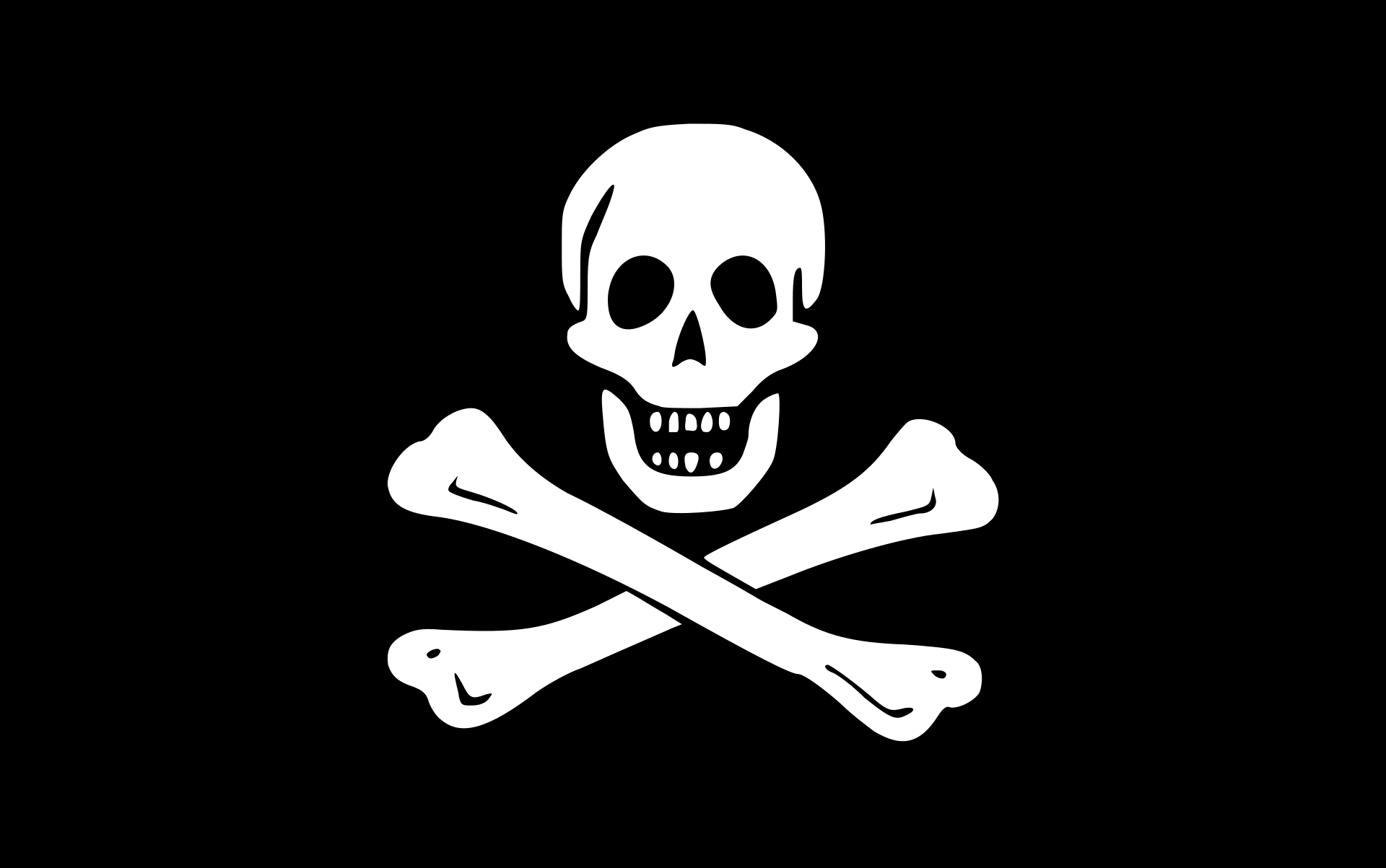
Jolly
Roger is the traditional English name for the flags flown to identify a
pirate ship about to attack, during the early 18th century (the later
part of the Golden Age of Piracy). The flag indicated that the ship’s
crew were not bound by standard rules of engagement and were likely to
attack with much ferocity and little mercy. The name Jolly Roger was
either an English corruption of the French term Joli Rouge (pretty red),
for the original red flags, or it referred to slang for the devil, Old
Roger. The skull and bones was the universal symbol for death with the
black background representing quarantine and disease. You can imagine
that seeing this flag would be quite intimidating.
The first recorded uses of the skull-and-crossbones symbol on naval flags date to the 17th century. It possibly originated among the Barbary pirates of the period, which would connect the black colour of the Jolly Roger to the Muslim Black Standard (black flag). But an early reference to Muslim corsairs flying a skull symbol, in the context of a 1625
slave raid on Cornwall, explicitly refers to the symbols being shown on a green flag.
There are mentions of
Francis
Drake's flying a black flag as early as 1585, but the historicity of this tradition has been called into question. Contemporary accounts show Peter Easton using a plain black flag in 1612; a plain black flag was also used by Captain Martel's pirates in 1716,
Blackbeard,
Charles
Vane, and Richard Worley in 1718, and Howell Davis in 1719.
An early record of the skull-and-crossbones design being used on a (red) flag by pirates is found in a December 6, 1687 entry in a log book held by the Bibliothèque nationale de France. The entry describes pirates using the flag, not on a ship but on land.
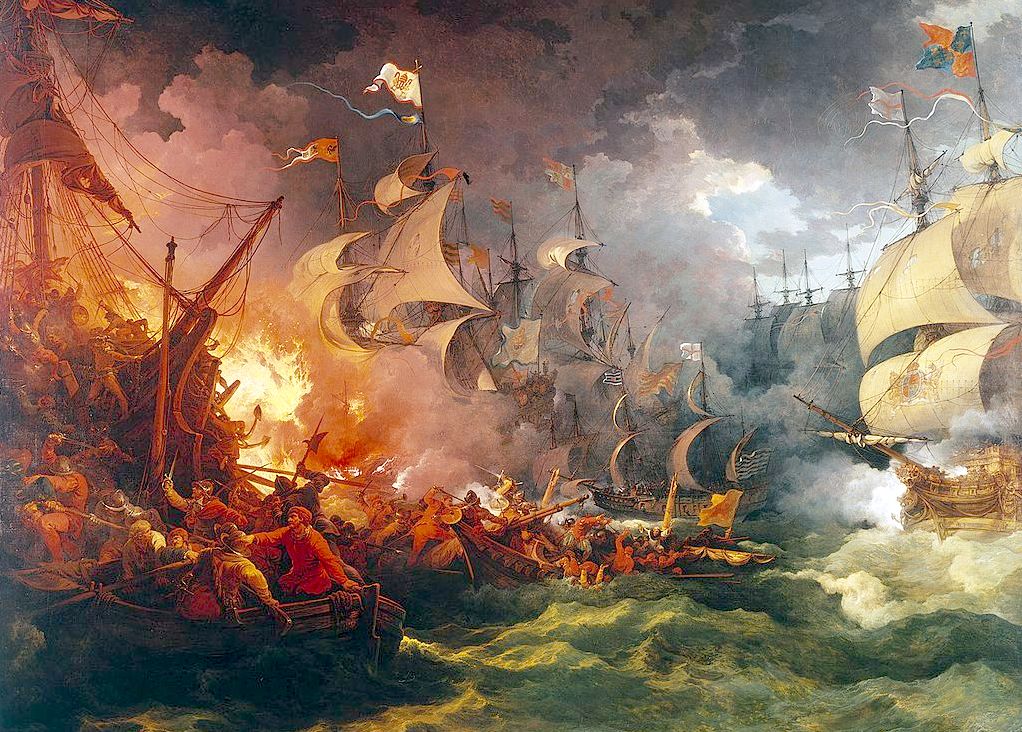
JOLLY ROGER NAME
Use of the term Jolly Roger in reference to pirate flags goes back to at least Charles Johnson's A General History of the Pyrates, published in Britain in 1724.
Johnson specifically cites two pirates as having named their flag "Jolly Roger": Bartholomew Roberts in June 1721 and Francis Spriggs in December 1723. While Spriggs and Roberts used the same name for their flags, their flag designs were very different, suggesting that already "Jolly Roger" was a generic term for black pirate flags rather than a name for any single specific design. Neither Spriggs' nor Roberts' Jolly Roger consisted of a skull and crossbones.
Richard Hawkins, who was captured by pirates in 1724, reported that the pirates had a black flag bearing the figure of a skeleton stabbing a heart with a spear, which they named "Jolly Roger". This description closely resembles the infamous flag of
Blackbeard (Edward Teach), who flew a similar design six years prior.
It is sometimes claimed that the term derives from "Joli Rouge" ("Pretty Red") in reference to a red flag used by French privateers. This is sometimes attributed to red blood, symbolizing violent pirates, ready to kill.
VISIBLE
COMMUNICATION OF INTENTIONS
Pirates didn't fly the Jolly Roger at all times.
They usually stocked a variety of flags, as would any vessel, and would normally fly a false flag or no colours until they had their prey within firing range. When the pirates' intended victim was within range, the Jolly Roger would be raised, often simultaneously with a warning shot.
The flag was probably intended as communication of the pirates' identity, which may have given target ships an opportunity to decide to surrender without a fight. For example, in June 1720, when
Bartholomew Roberts sailed into the harbour at Trepassey, Newfoundland with black flags flying, the crews of all 22 vessels in the harbour abandoned their ships in panic. It is claimed (without contemporary references) that if a ship then decided to resist, the Jolly Roger was taken down and a red flag (in the 20th Century sometimes called the "Bloody Red") was flown, indicating that the pirates intended to take the ship by force and without mercy.
This claim comes from only one source, in the mid-18th century Sir Richard Hawkins suggested that pirates gave quarter beneath the black flag, while no quarter was given beneath the red flag. However the cited content may simply relate to different Pirate captains, their ships, their chosen flag and particular operating practices.
In view of these models, it was important for a prey ship to know that its assailant was a pirate, and not a privateer or government vessel, as the latter two generally had to abide by a rule that if a crew resisted, but then surrendered, it could not be executed.
An angry pirate therefore posed a greater danger to merchant ships than an angry Spanish coast guard or privateer vessel. Because of this, although, like pirate ships, Spanish coast guard vessels and privateers were almost always stronger than the merchant ships they attacked, merchant ships may have been more willing to attempt resisting these "legitimate" attackers than their piratical counterparts.
To achieve their goal of taking prizes without a costly fight, it was therefore important for pirates to distinguish themselves from these other ships
that were also taking prizes on the seas.
Flying a Jolly Roger was a reliable way of proving oneself a pirate. Just possessing or using a Jolly Roger was considered proof that one was a criminal pirate rather than something more legitimate; only a pirate would dare fly the Jolly Roger, as he was already under threat of execution.
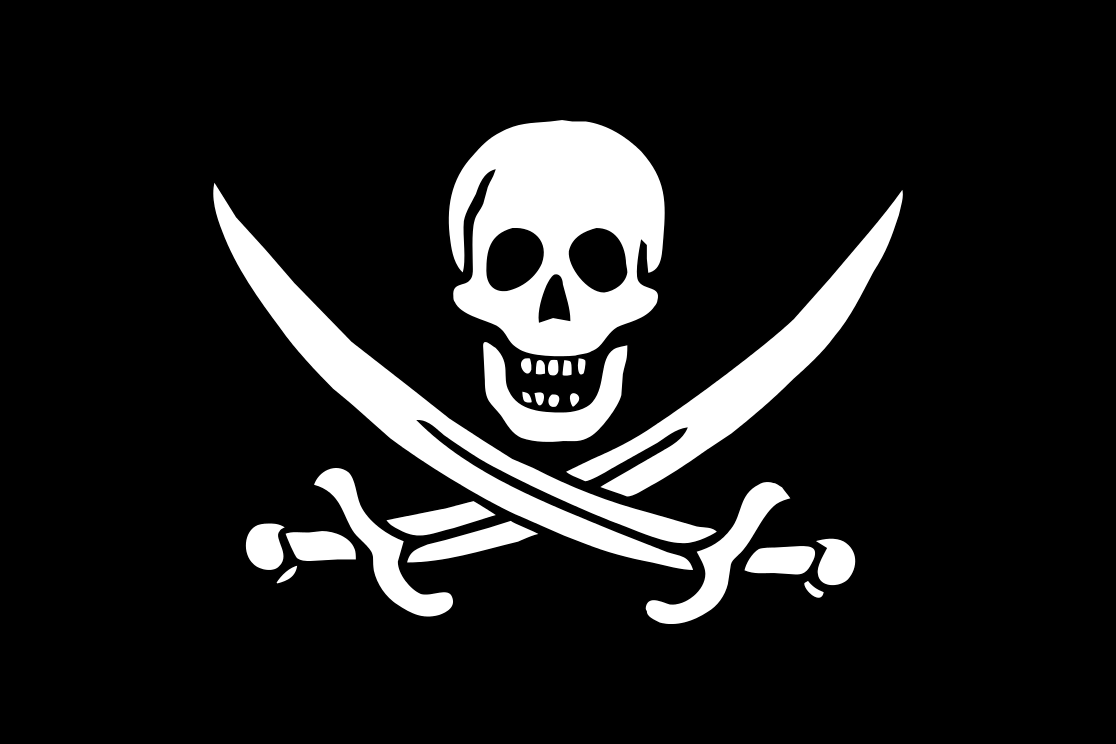
A
variation of the skull and crossbones, using cutlasses in place of leg
bones, probably more accurate depiction of how pirates
took ships by force and what happened to those who resisted. This flag
was used by John
Rackham, known as Calico Jack.
Another early reference to "Old Roger" is found in a news report in the Weekly Journal or British Gazetteer (London, Saturday, October 19, 1723; Issue LVII, p. 2, col. 1):
Parts of the West-Indies. Rhode-Island, July 26. This Day, 26 of the Pirates taken by his Majesty Ship the Greyhound, Captain Solgard, were executed here. Some of them delivered what they had to say in writing, and most of them said something at the Place of Execution, advising all People, young ones especially, to take warning by their unhappy Fate, and to avoid the crimes that brought them to it. Their black Flag, under which they had committed abundance of Pyracies and Murders, was affix'd to one Corner of the Gallows. It had in it the Portraiture of Death, with an Hour-Glass in one Hand, and a Dart in the other, striking into a Heart, and three Drops of Blood delineated as falling from it. This Flag they called Old Roger, and us'd to say, They would live and die under it.
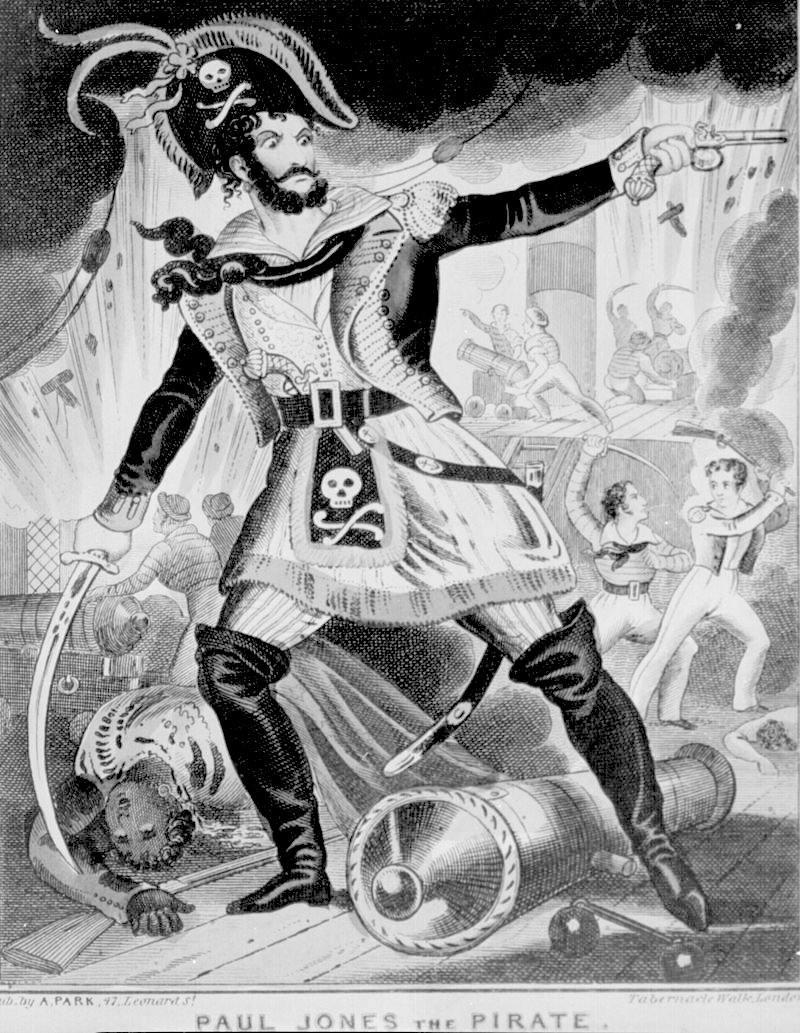
POPULAR
CULTURE
The Jolly Roger flag became a cliché of pirate fiction in the 19th century - "me hearties."
The "Golden Age of Piracy" was over by the mid-18th century, and piracy was widely suppressed by the 1800s, although the problem of Barbary pirates persisted until the French conquest of Algeria in 1830.
By the Victorian era, the pirate threat had receded enough for it to become a topos of boyish adventure fiction, notably influenced by Robert Louis Stevenson's adventure novel Treasure Island (1883). Gilbert and Sullivan's comic opera The Pirates of Penzance (which debuted in 31 December 1879) introduced pirates as comedic characters, and since the later 20th century, pirates sporting the Jolly Roger flag were often depicted as cartoonish or silly characters. J.M. Barrie also used it as the name of Captain Hook's pirate ship in Peter and Wendy (1904 play and 1911 novel); it was thus used in most adaptations of the character, including ABC's television series Once Upon a Time (2011-2018).
FILMS
In the film The Island (1980), the Jolly Roger is a skull with a red dot and crossbones with an hourglass on the bottom. In Disney's
Pirates of the
Caribbean, the Black Pearl flies a flag of skull over two crossed swords, which is not copyrighted as it is actually a copy of
Calico
Jack's flag, with the swords sometimes said to represent the two female pirates aboard his ship,
Anne Bonny and
Mary
Read.
MUSIC
Adam and the Ants' album Kings of the Wild Frontier (1980) includes the song, "Jolly Roger".
Kenny Chesney's single "Pirate Flag" is on his fourteenth studio album Life on a Rock (2013).
The cover of Iron
Maiden's album A Matter of Life and Death (2006) includes a version of a Jolly Roger depicting a helmeted Eddie and two assault rifles instead of bones, hanging from a tank.
On the cover of Michael Jackson's album Dangerous (1991), the Jolly Roger can be seen on the left side with the alteration of a skull over two swords.
The re-issued version of the Megadeth album, Killing Is My Business... and Business Is Good! (1985), shows a stylized Vic Rattlehead skull on top of crossed swords and crossed bones. This was based on Mustaine's original drawing for the cover which the band did not have enough money to produce at the time.
The "pirate" metal band Running Wild often references the Jolly Roger and other pirate related themes in their music. Their 3rd album is named Under Jolly Roger.
Another "pirate" metal band Alestorm also uses Jolly Roger and other pirate related themes in their music.
The Pirates, a spinoff of the band Johnny Kidd & the Pirates, released an album called Out of their Skulls featuring a skull with crossed guitars below it.
British DJ Eddie Richards released the acid house hit "Acid Man" in 1988, under a Jolly Roger alias.
SPORTS
A number of sports teams have been known to use variations of the Jolly Roger.
One of the best known in current use is the National Football League's Tampa Bay Buccaneers' adaptation of Calico Jack's pirate flag, with a carnelian red background instead of black, and an
American football positioned over the intersection of two crossed swords.
The supporters of FC St. Pauli, a sports club from Hamburg, Germany best known for its association football team, have adopted a variation of Richard Worley's flag as their own unofficial emblem.
The Jolly Roger is the popular icon of all University College Cork (Ireland) sports teams.
"Raise the Jolly Roger!" is used in a statement by the Major League Baseball's team Pittsburgh Pirates announcer Greg Brown when the Pirates win a game. Brown has become known for the phrase, his signature call, similar to other sports broadcasters, such as the Cincinnati Reds' announcer Marty Brennamen's phrase ('This one belongs to the Reds'), and former Pirates announcers Lanny Frattare ("There was no doubt about it!") and Bob Prince, who liked to end Pirates wins with similarly jovial statements.
Another such variation is the Las Vegas Raiders', which depicts a head with facial features, wearing an eye patch and a helmet, and crossed swords behind the helmet.
All these variations are seen as the logos of sporting teams in (Scotland):
• The Braehead Paisley Pirates/Paisley Pirates of the Scottish National League
•
The Paisley Buccaneers and Riversdale Pirates of the Scottish Recreational
Ice Hockey Conference
•
The East Kilbride Pirates American football team in BAFA Division 1
•
The Edinburgh Buccaneers basketball club of the Scottish Men's National League
The South African Football Association soccer team Orlando Pirates also has the classic Jolly Roger as their logo. Central Coast United FC in Australia use the Jolly Roger in their club crest and their active supporters are known as the Graveyard.
The athletic teams of East Carolina University used a stylized Jolly Roger as one of their logos. This particular variation includes an earringed and eyepatch-wearing skull donning a tricorn of purple and gold (the
school's colours) emblazoned over two crossbones. This logo appears on the helmets of the school's football team, and an elaborate pre-game ritual takes place prior to each home contest wherein a flag bearing the university's Jolly Roger logo is raised on a special flagpole located behind the west end zone prior to the opening kickoff. Immediately prior to the start of the fourth quarter, the normal (black) Jolly Roger is lowered and replaced with a flag bearing the ECU Jolly Roger on a red background, indicating that the Pirates will grant their opponents "no quarter".
The Blackshirts, the starting defensive unit players for the Nebraska Cornhuskers
football team, are represented by a Jolly Roger, somewhat similar to Richard Worley's flag but with the skull encased in the team's football helmet. Additionally, the players and fans often celebrate by "throwing the bones", where they cross the forearms in front of the chest in an 'X' imitating the logo, and the student section at Memorial Stadium, Lincoln is known as the 'Boneyard', where the logo is often displayed on banners, signs, and flags in an act of intimidation.
When Viktor Korchnoi opposed Anatoly Karpov for the World Chess Championship 1978, he was a defector from the Soviet Union and momentarily stateless; so he played with a miniature Jolly Roger at the chess table.
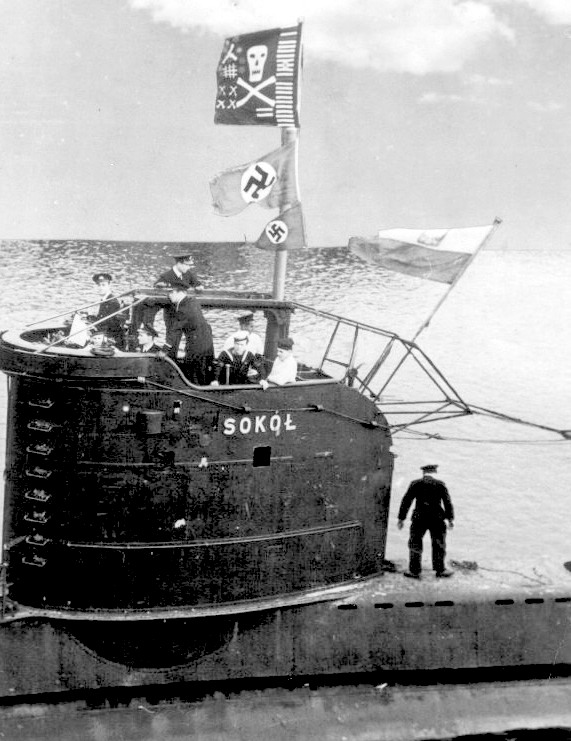
WWII
- Polish submarine ORP Sokół returning to base in 1944. A Jolly Roger flag and two captured Nazi flags are flying from the periscope mast
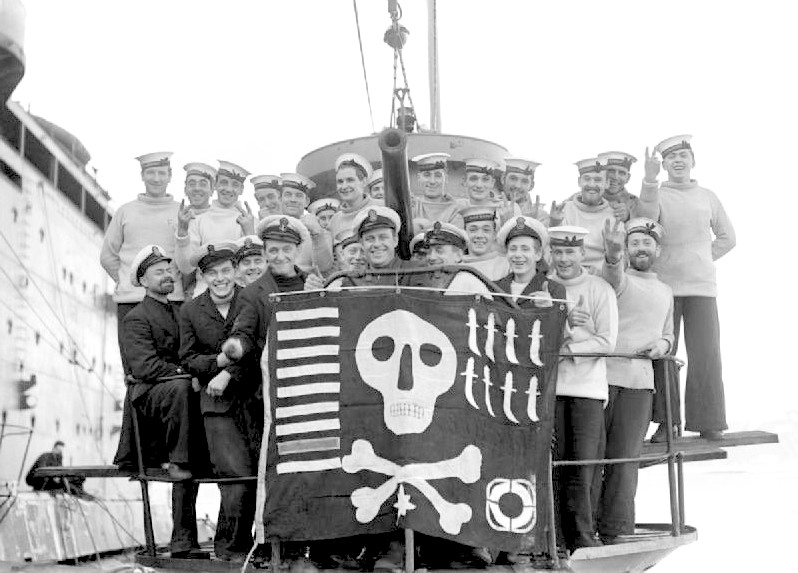
WWII
- The personnel of the British submarine HMS Utmost showing off their Jolly Roger in February 1942. The markings on the flag indicate the boat's achievements: nine ships torpedoed (including one warship), eight 'cloak and dagger' operations, one target destroyed by gunfire, and one at-sea rescue.
MODERN MILITARY USE - SUBMARINES
Following the introduction of submarines in several navies circa 1900, Admiral Sir Arthur Wilson, the First Sea Lord of the British Royal Navy, stated that submarines were "underhanded, unfair, and damned un-English", and that he would convince the British Admiralty to have the crews of enemy submarines captured during wartime hanged as pirates.
In September 1914, the British submarine HMS E9 successfully torpedoed the German cruiser SMS Hela. Remembering Wilson's statements, commanding officer Max Horton instructed his submariners to manufacture a Jolly Roger, which was flown from the submarine as she entered port. Each successful patrol saw Horton's submarine fly an additional Jolly Roger until there was no more room for flags, at which point Horton had a large Jolly Roger manufactured, onto which symbols indicating E9's achievements were sewn. A small number of other submarines adopted the practice: HMS E12 flew a red flag with the skull and crossbones on return from a foray into the Dardanelles in June 1915, and the first known photograph of the practice was taken in July 1916 aboard HMS H5.
The practice restarted during World War II. In October 1941, following a successful patrol by HMS Osiris, during which she sank the Italian destroyer Palestro, the submarine returned to Alexandria, but was ordered to remain outside the boom net until the motorboat assigned to the leader of the 1st Submarine Flotilla had come alongside. The flotilla leader wanted to recognise the boat's achievement, so had a Jolly Roger made and delivered to Osiris. After this, the commanders of submarine flotillas began to hand out the flags to successful submarines.
Although some sources claim that all British submarines used the flag, the practice was not taken up by those submarine commanders who saw it as boastful and potentially inaccurate, as sinkings could not always be confirmed. During the war, British submarines were entitled to fly the Jolly Roger on the day of their return from a successful patrol: it would be hoisted as the boat passed the boom net, and remain raised until sunset.
Symbols on the flag indicated the history of the submarine, and it was the responsibility of the boat's personnel to keep the flag updated. The Royal Navy Submarine Museum (which, as of 2004, possessed fifteen Jolly Rogers) recognises 20 unique symbols. A bar denotes the torpedoing of a ship: red bars indicated warships, white bars represented merchant vessels, and black bars with a white "U" stood for
U-boats. A dagger indicated a 'cloak and dagger' operation: typically the delivery or recovery of shore parties from enemy territory. Stars (sometimes surrounding crossed cannon) stood for occasions where the deck gun was fired.
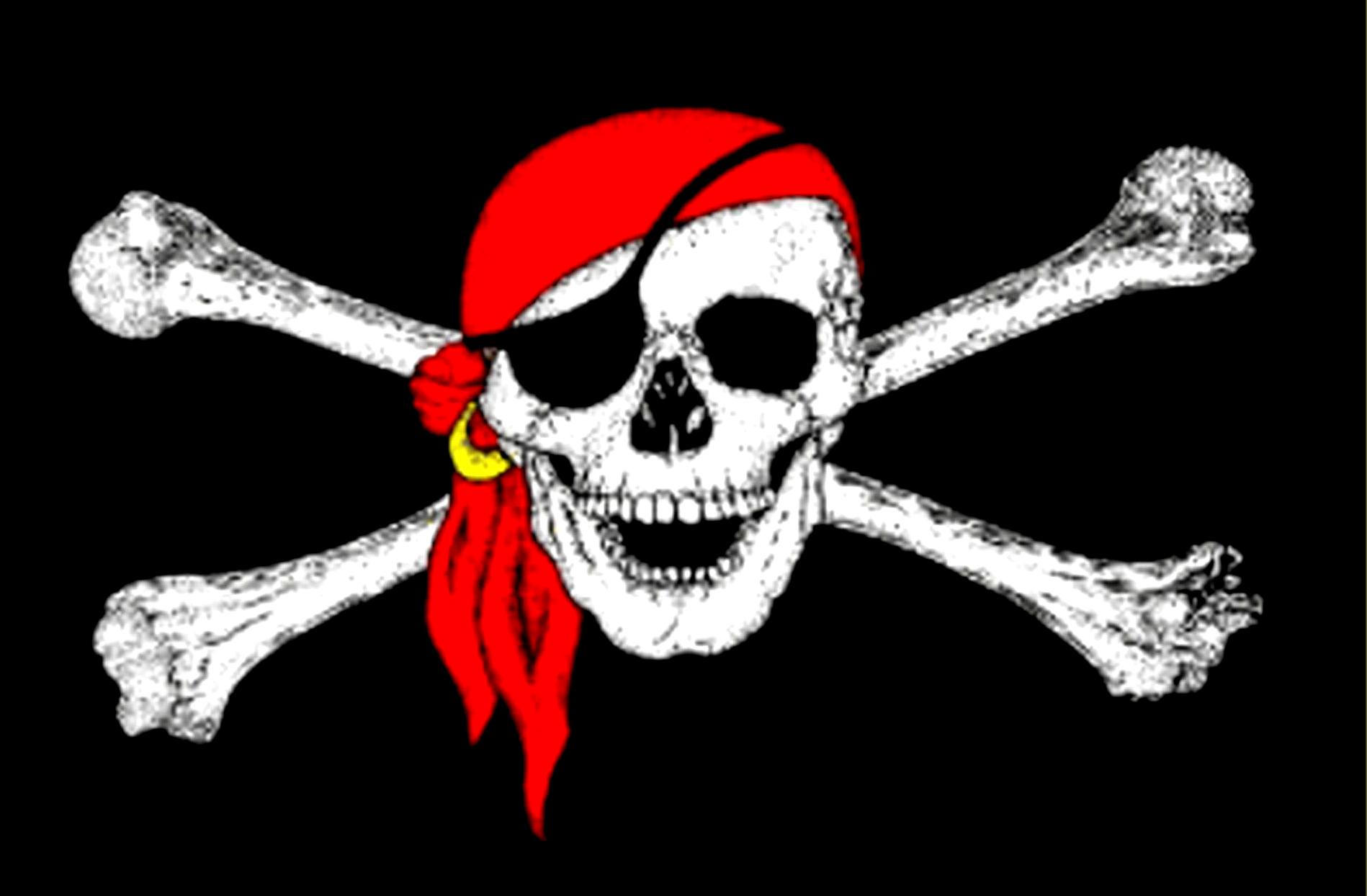
A
more graphic skull and cross bones with the skull sporting a red
bandana, something like that Captain
Jack Sparrow might wear. Piracy can be any unsocial or death dealing
act, such as dumping old fishing
nets, or whaling
for species that are in danger (endangered) of extinction due to low
numbers. On the island of Tasmania, white settlers hunted the Dodo to
extinction, being very easy to kill, as they were not afraid of humans.
The species in now lost forever. Biodiversity is just that, diverse
biological evolution that cannot be replaced once extinguished. Even
fishing out fisheries is piracy in our view. Once they are fished out,
they never come back. Loosing a whale species would be devastating.
Unfortunately, with plastic litter poisoning fish stocks and with
desertification reducing arable land, we are facing possible food
shortages, measured against a continuously growing human population. At
that point, whaling is sure to rise to meet the need for food. We almost
killed off a number of species during the golden age of whaling, when we
did not know so much about the dangers.
Minelaying operations were shown by the silhouette of a sea mine: a number inside the mine indicated how many such missions. A lighthouse or torch symbolised the boat's use as a navigational marker for an invasion force; the latter more particularly associated with Operation Torch. Rescue of personnel from downed aircraft or sunken ships was marked by a lifebuoy. Unique symbols are used to denote one-off incidents: for example, the Jolly Roger of HMS Proteus included a can-opener, referencing an incident where an Italian destroyer attempted to ram the submarine, but ended up worse off because of damage to the destroyer's hull by the submarine's hydroplanes, while HMS United added a stork and baby when the boat's commander became a father while on patrol.
Flying the Jolly Roger continued in the late 20th century and on into the 21st. HMS Conqueror raised the flag decorated with the silhouette of a
cruiser to recognise her successful attack on the Argentine cruiser ARA General Belgrano during the Falklands War. Several submarines returning from missions where Tomahawk cruise missiles were fired fly Jolly Rogers with tomahawk axes depicted, with crossed tomahawks indicating an unspecified number of firings, or individual axes for each successful launch. The Jolly Roger has been adopted as the logo of the Royal Navy Submarine Service.
The practice, while commonly associated with British submarines, is not restricted to them. During
World War II, Allied submariners working with Royal Navy fleets adopted the process from their British counterparts. While operating in the
Mediterranean, the Polish submarines ORP Sokół and ORP Dzik were presented with Jolly Rogers by General Władysław Sikorski, and continued to update them during the war.
At least one British surface ship recorded their U-boat kills through silhouettes on a Jolly Roger. The Australian submarine HMAS Onslow flew the Jolly Roger in 1980, following her successful participation in the Kangaroo 3 wargame as an opposing submarine: the flag bore the silhouettes of the seven surface ships involved, as during the exercise, Onslow had successfully 'sunk' all seven.
During the Vietnam war an urgent airfield was needed at Quảng Trị by the United States forces. U.S. Seabee Battalions 1, 3, 4, 7, 11, 74, 121, and 133 all sent detachments of men and equipment to get the job done. Those detachments dubbed themselves the Ghost Battalion and chose the Jolly Roger for the Battalion's colours.
The Kuperjanov Infantry Battalion, part of the Estonian Land Forces, uses the Jolly Roger as its insignia.
At least twice in 2017, the USS Jimmy
Carter, an American attack submarine modified to support special forces operations, returned to its home port flying a Jolly Roger. The reason for the flag in both cases is not known.
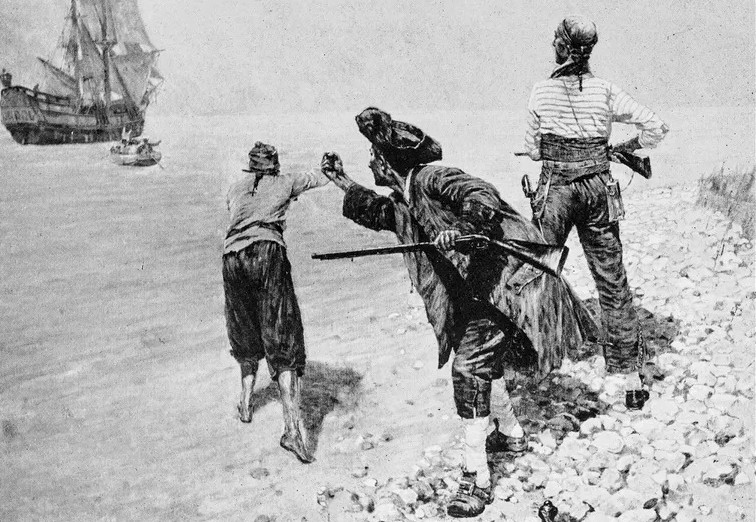
Marooning
pirates on a desert island was a common practice, rather than killing an
old shipmate, just because they had their differences.
Please use our
A-Z INDEX to
navigate this site







